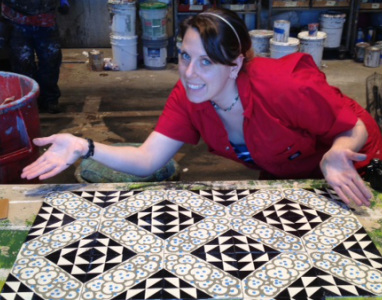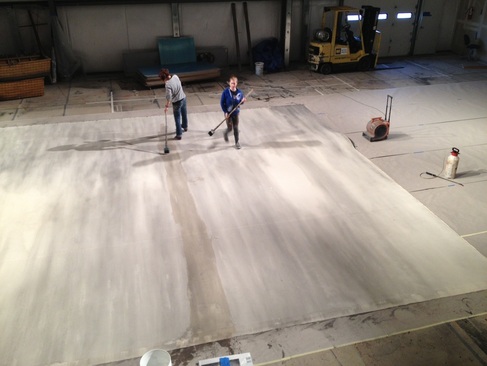
This week in the shop, we have been working VERY hard on our upcoming production of "The Unfortunates." A world premier musical, it promises to be moving, entertaining, frightening, and fun.
From the OSF website:
"A musical pilgrimage through uniquely American genres delivers five prisoners to salvation — or at least keeps the terror at bay. Facing an uncertain end, they bring to life the story of Big Joe, a tough bartender who risks everything to save the armless courtesan Rae from a deadly plague. Combining the heat of a gospel revival with the sweet sorrow of the blues, 'The Unfortunates' convinces us that any great challenge can be faced with dignity, grace, and compassion."

This show is filled with layers, including a backdrop, several scrims, a bounce, rear projection screens, and even a detailed tile floor.
Here, you see Amanda Haverick, Kira Nehmer and Erin Young painting the bounce in an airy smoky print.
In order to create the intricate tile pattern, we developed an assembly line of applying a vinyl stencil to each tile and rolling on the paint. The slideshow below shows scenic artists Amada Haverick, Kira Nehmer and I as well as our intern Erin Young laying out the tiles, applying the stencils using transfer tape, and adding the finishing paint strokes with a pencil eraser.
First, the shop cut more than 700 individual tiles from masonite, a board made of woodpulp and glue, and sorted them into stacks to be painted in three different styles. Two are reletively plain, while the remaining 400 display a fairly intricate 5 color cloud and triangle pattern. To create this intricate pattern quickly and efficiently, we decided to use the vinyl cutter to create a stencil. The vinyl cutter is a fantastic tool in the likeness of a printer, but instead of printing with ink, the printer in equipped with a tiny knife that cuts a design into a giant vinyl sticker that we buy by the roll. The cutter can make many copies of the same sticky stencil very quickly and then all we have to do is apply the design to the tiles and paint them as we would a stencil. First, we remove the sections that are to be painted grey, and paint them, then remove more of the design and paint them the next color, blue, and so on. In this way, we can paint each color of each section and then finally remove the last of the vinyl, leaving a perfectly clean painted tile. Then we need to seal them to look glazed, and age them.
Since the tile floor belongs to a bombed out bar, the tiles needed to look old and broken. Now comes the fun part: In some cases, all we needed to do was chip the paint or let some of the vinyl rip some paint off leaving a burnt look, but in others, we actually got to break the tiles in half, or break off corners to give them a chipped look. All of the tiles will get an uneven brown grungy wash. The final look will be achived when they are mounted in the Thomas Theatre in their patterns around the traps in the floor to look like open holes left from a bombardment.